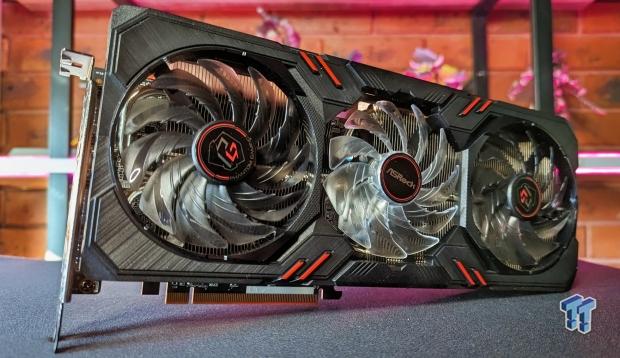
The Bottom Line
Pros
- + Great build quality
- + Excellent thermal performance
- + Trumps the RTX 3060 as a mainstream 1080p performer
- + Priced below USD 300
Cons
- - The sizable 1440p performance drop-off
- - Ray-tracing performance is a letdown
- - Falls behind the GeForce RTX 4060 in most tests
Should you buy it?
AvoidConsiderShortlistBuyIntroduction
With its MSRP of USD 269 and performance targeting the 1080p gaming sector, the AMD Radeon RX 7600 is every bit the mainstream option in the RDNA 3 line-up. With that in mind, it always makes the appearance of a seemingly large mainstream GPU with three fans a little confusing - because it feels like overkill when mainstream cards like the Radeon RX 7600 look good when they're small, compact, and as quiet as possible.
Naturally, this thought was running through my head when the ASRock Radeon RX 7600 Phantom Gaming 8GB OC arrived, but the good news is that it looks and feels smaller than many two-fan Radeon RX 7600 GPUs.
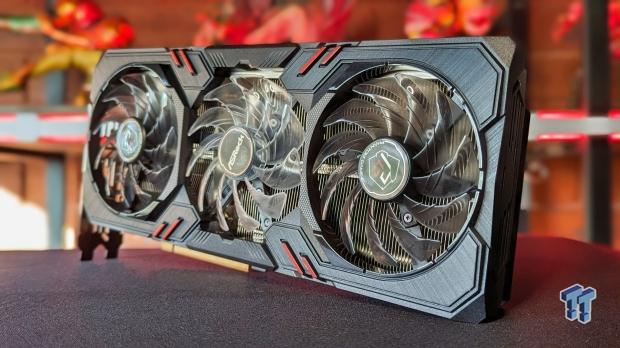
Why is this the case? Well, it mostly comes down to the 2.4-slot thickness giving the GPU a slim look matched by the lightweight 894-gram build for a triple fan graphics card. With a retail price of around USD 289, this premium Radeon RX 7600 from ASRock adopts the company's impressive Phantom Gaming aesthetic and build quality, focusing on delivering exceptional cooling performance alongside some dazzling RGB action.
At this point, there's not a lot of mystery surrounding the Radeon RX 7600 hardware and what the mainstream RDNA 3 GPU is capable of - that will happen when you benchmark multiple models. As an OC edition, there are improved clock speeds out-of-the-box, which can be tweaked further with software. From performance to the bold physical design and great RGB lighting paired with ASRock's excellent cooling, this is one of the best Radeon RX 7600 options. Let's dig in.

The RDNA 3 Generation
"The world's first chiplet gaming GPU" is how AMD described its new RDNA 3-based GPUs when it lifted the lid on the new Radeon RX 7000 Series. In layperson's terms, the GPU chip isn't just one big square or die anymore, with billions of transistors all arranged in a single layout. Like with its Ryzen CPU range, which embraced chiplet design to great effect (look at how Ryzen has grown in popularity over the years), bringing this design philosophy into the GPU space felt like the natural evolution for AMD's Radeon brand.
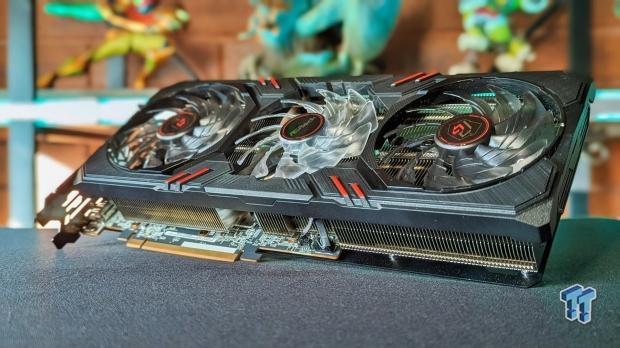
For RDNA 3, what was once a single Graphics Compute Die (GCD) has now split into a GCD plus a Memory Cache Die (MCD). The GCD still makes up most of the hardware grunt and uses the newer 5nm process technology - a step up from RDNA 2's 7nm process. Interestingly, the MCD uses 6nm process technology, which allows AMD to keep costs down as the complexity and cost of manufacturing high-end tech continue to rise.
And to mitigate any performance impact that could arise from going the chiplet route, AMD has also managed to include the "fastest chiplet interconnect in the world," with speeds of 5.3 TB/s. That said, the Radeon RX 7600 and entry-level models using the 'Navi 33' GPU follow a more traditional single-chip setup using 6nm process technology to help keep costs down. But with the same RDNA 3 architecture.
AMD's RDNA 3 architecture features second-generation AMD Infinity Cache, another CPU-like feature designed to boost performance in 1440p and 4K gaming - a "bandwidth amplifier" that sits alongside the GDDR6 memory interface. It helps alleviate the need for more expensive and power-hungry memory buses and is one of those forward-thinking designs we love seeing.
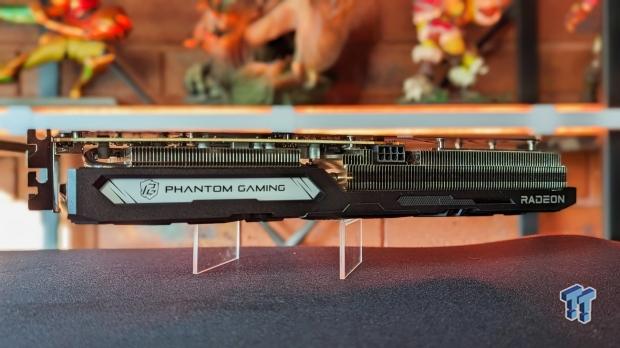
RDNA 3 represents a significant leap forward for AMD regarding ray-tracing and AI accelerators too. RDNA 3 GPUs feature the second generation of dedicated RT hardware and new hardware-based AI acceleration. Real-time ray tracing is hardware intensive; this is one area many were looking for AMD to improve compared to RDNA 2. Which, admittedly, was the company's first attempt at hardware-based ray tracing.
RDNA 3 GPUs are the first graphics cards supporting the new DisplayPort 2.1 spec. The latest DisplayPort interface supports up to 4K 480Hz and even 8K 165Hz, which makes it more of a future-proofing measure than something applicable today. But the real benefit comes with 12-bit HDR support and full Rec2020 coverage for improved color accuracy and detail.
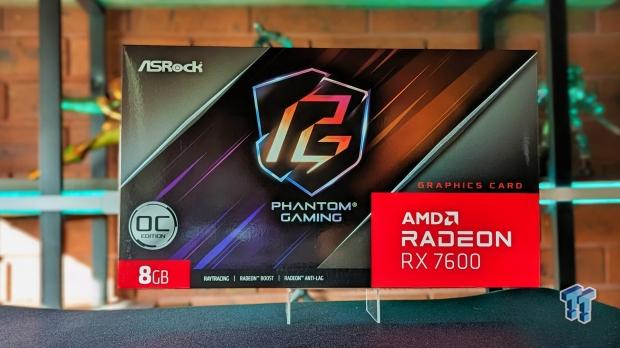
RDNA 3 also introduces hardware-based AV1 encoding to step up its video game for content creators, which means better quality video using the same bitrate. Very cool. For gamers, the introduction of AMD FSR 2 rendering is fully supported here and helps improve performance in intensive games. FSR 2 support might not be as widespread as NVIDIA DLSS, but its addition to games like Cyberpunk 2077 and Star Wars Jedi: Survivor is a great sign. Plus, as the tech is fully supported on Xbox Series X|S and PlayStation 5 (with both consoles using AMD graphics hardware), in-game FSR support should grow as time passes.
AMD has yet to formally showcase or reveal what its DLSS 3-like FSR 3 frame generation technology will look like or whether it will be exclusive to RDNA 3-based hardware, so we'll have to wait and see on that front. Ultimately, RDNA 3 is an impressive leap forward for AMD, bringing massive changes to the underlying hardware while delivering a sizable performance leap over the previous RDNA 2 generation.
Specs and Test System
Specifications
Here we can see how the specs and hardware stack up for the AMD Radeon RX 7600 compared to the previous generation's AMD Radeon RX 6600.
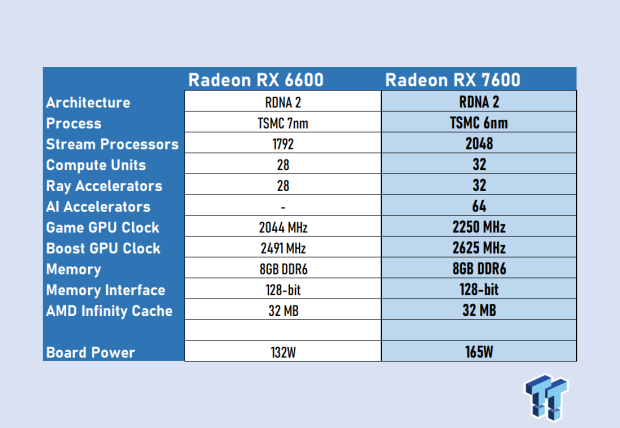
Unlike the flagship Radeon RX 7900 XT and XTX models (and the upcoming Radeon RX 7800 XT), the mainstream Radeon RX 7600 presents the latest RDNA 3 architecture in its most cost-effective form. This means using a 6nm process node on a single monolithic die compared to the 5nm and 6nm processes in the multi-chip Radeon RX 7900 Series. From there, you've also got the obligatory next-gen increase in things like Stream Processors, Compute Unit counts, and GPU clock speeds.
The ASRock Radeon RX 7600 Phantom Gaming 8GB OC pushes clock speeds higher than what was found in AMD's reference design, with a Boost Clock speed of up to 2755 MHz and a Game Clock speed of 2355 MHz. A modest increase over the 2725 MHz of the reference model but a welcome addition when you factor in ASRock's premium cooling setup. It's also a sizable clock speed increase compared to the previous generation's Radeon RX 6600.
Like the GeForce RTX 4060, the Radeon RX 7600's more expensive competition, you're looking at a similar memory configuration with 8GB of GDDR6 on a 128-bit bus. Thankfully bandwidth improves with the addition of AMD Infinity Cache, which increases the effective bandwidth to 476.9 GB/s, but the 8GB capacity is better suited for 1080p gaming versus 1440p. Per the benchmarks below, the ASRock Radeon RX 7600 Phantom Gaming can still play certain games at a higher resolution.
Interestingly going from RDNA 2 to RDNA 3 sees the mainstream Radeon RX 7600 increase its power draw to 165W (or 185 in the OC variant seen here) compared to the Radeon RX 6600's 132W. This indicates that AMD couldn't hit the same efficiency heights that NVIDIA has managed with its new Ada-powered GeForce RTX 4060. The ASRock Radeon RX 7600 Phantom Gaming 8GB OC is not a GPU you'd consider power-hungry by any stretch of the imagination, but this is worth pointing out nonetheless.
- GPU: AMD Radeon RX 7600
- Model: ASRock Radeon RX 7600 Phantom Gaming 8GB OC
- Interface: PCI Express 4.0
- Stream Processors: 2048
- Clock Speeds: Boost Clock: Up to 2755 MHz, Game Clock: 2355 MHz
- Memory: 8GB GDDR6
- Memory Speed: 18 Gbps
- Memory Interface: 128-bit
- Display Connections: 1 x HDMI 2.1, 3 x DisplayPort 2.1
- Power Connectors: 1 x 8-pin
- Total Board Power: 185W
- What's in the Box: ASRock Radeon RX 7600 Phantom Gaming 8GB OC, Quick Installation Guide
Kosta's Test System
- Motherboard: MSI MPG X670E Carbon Wi-Fi
- CPU: AMD Ryzen 9 7900X
- Cooler: Corsair iCUE H100i RGB PRO XT Liquid CPU Cooler
- RAM: 64GB (2x32GB) Corsair DOMINATOR PLATINUM RGB DDR5 DRAM 5200MHz
- SSD: Sabrent Rocket 4 Plus-G M.2 PCIe Gen 4 SSD 4TB, Sabrent Rocket 4 Plus M.2 PCIe Gen 4 SSD 8TB
- Power Supply: Thermaltake Toughpower GF1 850W
- Case: Thermaltake Core P3 Tempered Glass Snow
- OS: Microsoft Windows 11 Pro 64-bit
Physical Design and Cooling
With dimensions of 305 x 131 x 48mm, the ASRock Radeon RX 7600 Phantom Gaming 8GB OC is larger than AMD's reference Radeon RX 7600. However, being a custom model, it presents a sleeker RGB-friendly aesthetic with a 2.4-slot thickness and weight that still make it feel every bit like a mainstream GPU. Translation; it's lightweight compared to the flagship Radeon RX 7900 Series and other high-end GPUs.
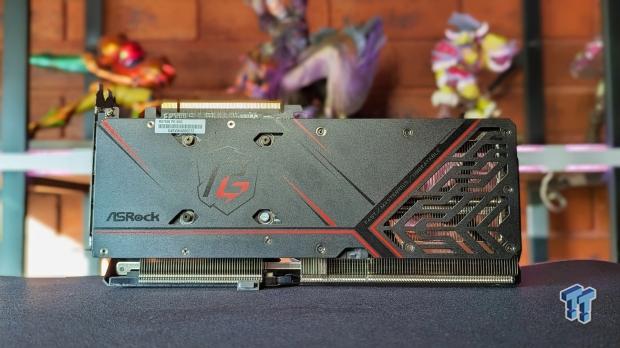
From a purely visual perspective, it features a cool design in that the fans are translucent. Still, only the middle fan lights up with RGB action with additional red flourishes on the side and around the GPU to remind you that it's part of the Radeon family. Of course, looks aren't everything (but I'd argue it's an important part of picking the right GPU), with the triple fan setup here serving as the basis for ASRock's Phantom Gaming 3X Cooling System.
With three striped axial fans designed for enhanced airflow and v-shaped fins and air vents, the ASRock Radeon RX 7600 Phantom Gaming 8GB OC has ample cooling to keep temperatures low when gaming. It's the coolest (temp-wise) Radeon RX 7600 we've tested to date - where you're looking at in-game temps of around 10 degrees lower than AMD's reference design-an impressive feat on behalf of ASRock.
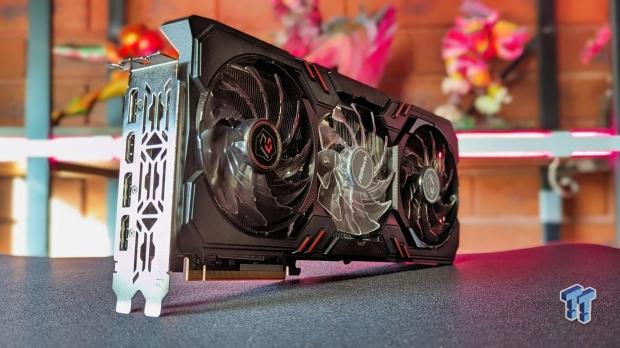
Elsewhere the GPU features many of the hallmarks you expect to find in a premium release from a wide copper base to maximize GPU contact, premium thermal pads, a metal backplate, and a custom PCB created from high-quality materials. The ASRock Radeon RX 7600 Phantom Gaming 8GB also features a 0dB silent mode for when temps drop below a certain level, with the RGB lighting being fully customizable via ASRock's easy-to-use Polychrome Sync software.
Benchmarks - 15 Game Averages
The Games and Tests
In 2023 PC gaming is a complicated and varied space, from indie games to major blockbuster releases and titles that push hardware and technology to their limit with the adoption of effects like real-time ray-tracing.
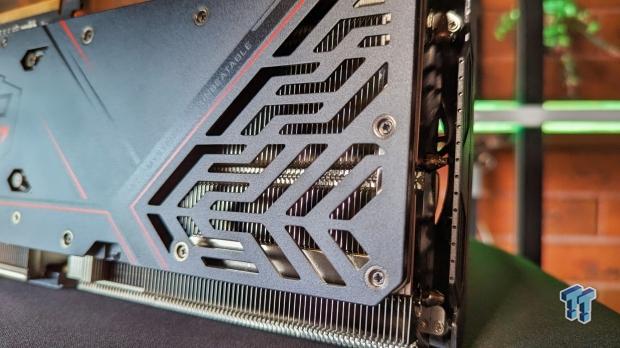
This is all a way of saying that the 15 in-game benchmarks we've chosen (and run at 1080p and 1440p) represent a wide range of styles, not only in terms of genres, like first-person shooters and racing games but also in the API technology (DirectX 11, 12) and cutting-edge features like ray tracing and upscaling technology.
Results include DLSS and FSR 2, where possible, as both technologies are the sorts of things, especially in 1440p and 4K, which you'd turn on. Six of the 15 game benchmarks also feature ray tracing. Also, each title is set to ultra-equivalent quality settings to push GPU hardware and minimize CPU bottlenecks at higher resolutions.
Also, it's just fun to max out a game's visual settings and see the results. Here's the breakdown of games, graphics settings, and what's being tested.
- Assassin's Creed Valhalla: Ultra High-quality settings, with the in-game benchmark tool used.
- Borderlands 3: Ultra quality settings, with the in-game benchmark tool used.
- Call of Duty: Modern Warfare II: Ultra quality setting, in-game multiplayer benchmark tool used.
- Cyberpunk 2077: Ultra quality setting, in-game benchmark tool used. AMD FSR and NVIDIA DLSS results are included.
- Cyberpunk 2077 (RT): Ray tracing Ultra quality setting, in-game benchmark tool used. AMD FSR and NVIDIA DLSS results are included.
- DOOM Eternal (RT): Ultra Nightmare quality setting with ray-tracing enabled, the opening of Mars Core campaign level used to benchmark.
- F1 22 (RT): Ultra High-quality setting with ray tracing, one lap of the Bahrain track benchmarked. AMD FSR and NVIDIA DLSS results are included.
- Forza Horizon 5 (RT): Extreme quality setting with ray tracing enabled, in-game benchmark tool used. AMD FSR and NVIDIA DLSS results are included.
- Hitman (RT): Ultra-quality settings with ray-tracing, Dubai scene benchmarked. AMD FSR and NVIDIA DLSS results are included.
- Horizon Zero Dawn: Ultimate quality setting, in-game benchmark used.
- Marvel's Guardians of the Galaxy (RT): Ultra quality setting with ray tracing enabled, the in-game benchmark tool used.
- Rainbow Six Extraction: Ultra quality settings and in-game benchmark tool used.
- Red Dead Redemption 2: Maximum quality settings, with in-game benchmark tool used. AMD FSR and NVIDIA DLSS results are included.
- The Division 2: Ultra quality settings with in-game benchmark tool used.
- Total War: Warhammer III: Ultra-quality settings with the in-game Battle Benchmark tool used.
15 Game Average FPS - 1080p Results
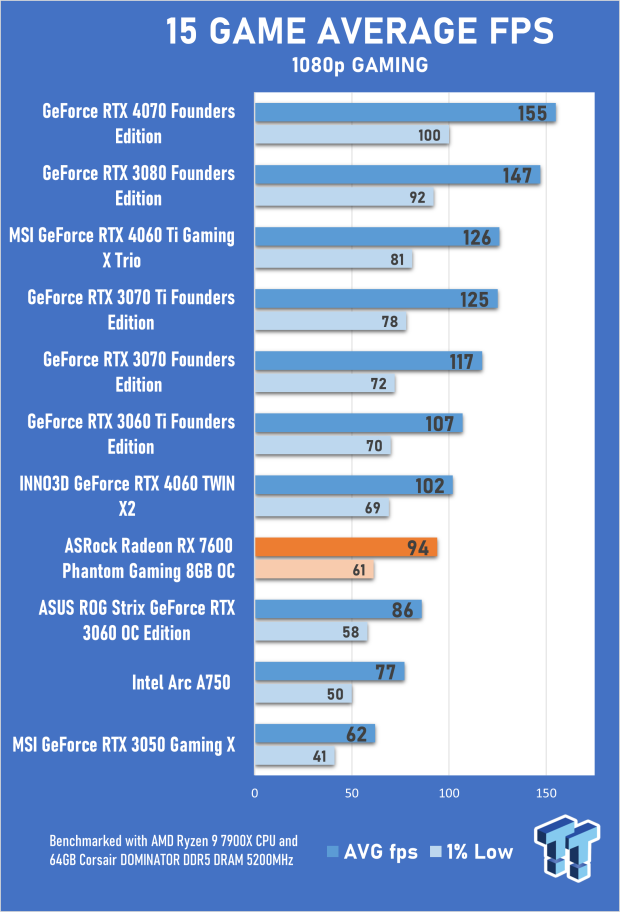
Without the previous generation's Radeon RX 6600 on hand to present a clear picture of the gen-on-gen performance uplift, comparisons will pit the ASRock Radeon RX 7600 Phantom Gaming 8GB against the current mainstream champ (according to the latest Steam Hardware Survey data), the GeForce RTX 3060. Plus, NVIDIA's successor and the Radeon RX 7600's current-gen competitor, the GeForce RTX 4060.
Okay, with that out of the way, with AMD's mainstream RDNA 3 GPU targeting mainstream 1080p performance - across our 15-game benchmark suite that includes several titles with ray-tracing, the average frame rate of 94 fps is great. As is the 1% low average of 61 fps.
Compared to the GeForce RTX 3060, this is a 9.5% improvement - which is not exactly earth-shattering but a decent uplift. With the performance sitting between the GeForce RTX 3060 and GeForce RTX 4060, the Radeon RX 7600 is roughly 7.8% slower than the new GeForce RTX 4060 for 1080p gaming. Naturally, performance varies from title to title; the ASRock Radeon RX 7600 Phantom Gaming 8GB shines in Call of Duty: Modern Warfare II, outperforming the GeForce RTX 4060 by an impressive 20.6% margin.
For the most part, the average 1080p performance you see here is reflected in most of the games benchmarked, though where the Radeon RX 7600 falters seems to be with titles that feature lots of real-time ray-tracing effects - like Cyberpunk 2077 and Hitman. Cyberpunk 2077 in RT Ultra mode is virtually unplayable on the Radeon RX 7600, falling behind even the GeForce RTX 3050.
14 Game Average FPS - 1440p Results
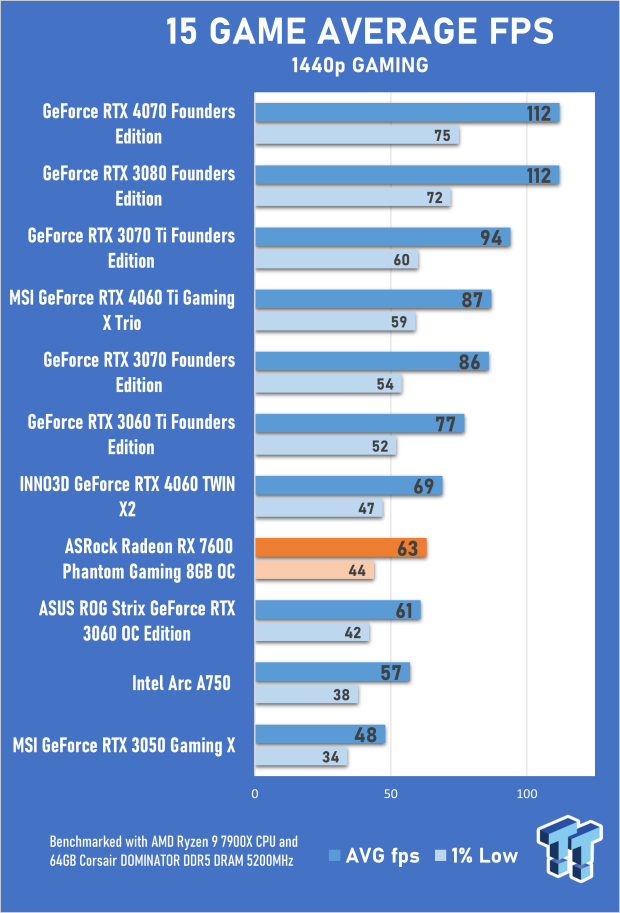
Bumping up the resolution to 1440p, the ASRock Radeon RX 7600 Phantom Gaming 8GB maintains an average frame rate above 60fps, though the performance drop-off is quite huge compared to 1080p - in the region of 33%. This is common for GPUs as increasing the resolution means more pixels to render; for example, 4K has eight times the pixels count compared to 1080p. Although the 60 fps and higher performance in games like Call of Duty: Modern Warfare II, Assassin's Creed Valhalla, and Red Dead Redemption with max settings is great to see, the drop-off reinforces the Radeon RX 7600 as a GPU best suited for 1080p gaming.
At 1440p, AMD's FSR 2 upscaling can help bridge the gap - performance-wise - but at this resolution, the visual fidelity does suffer compared to NVIDIA DLSS and even Intel's XeSS running natively on Arc GPU hardware. Without upscaling, the 1440p performance for the ASRock Radeon RX 7600 Phantom Gaming 8GB is only 3.3% faster than the GeForce RTX 3060 and roughly 8.7% slower than the GeForce RTX 4060.
Benchmarks - 3DMark FireStrike
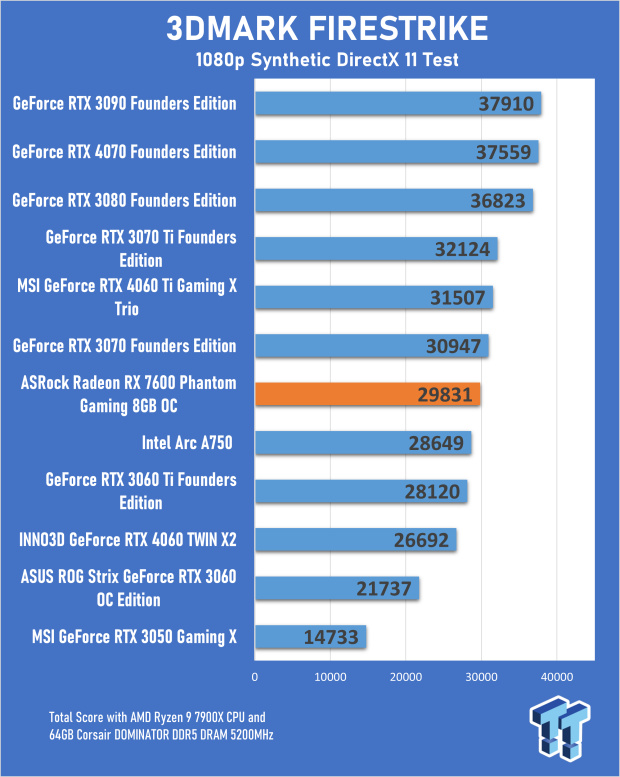
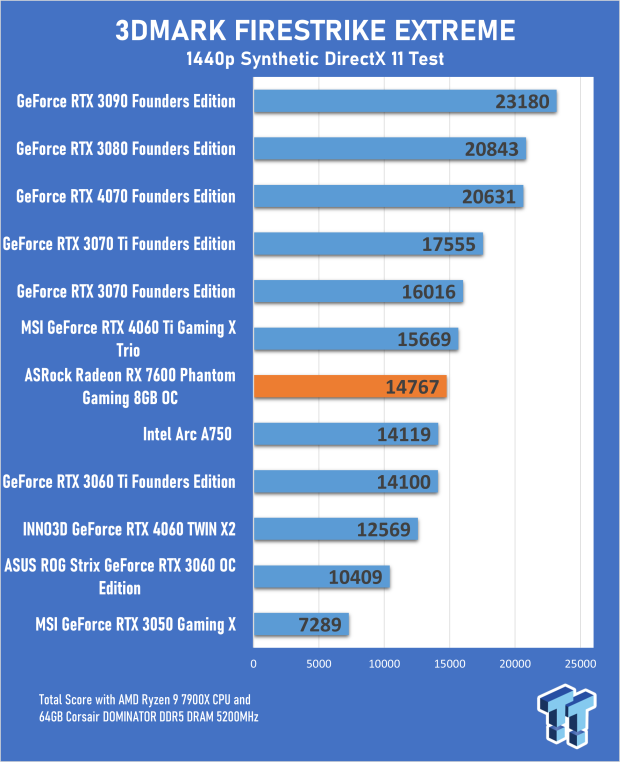
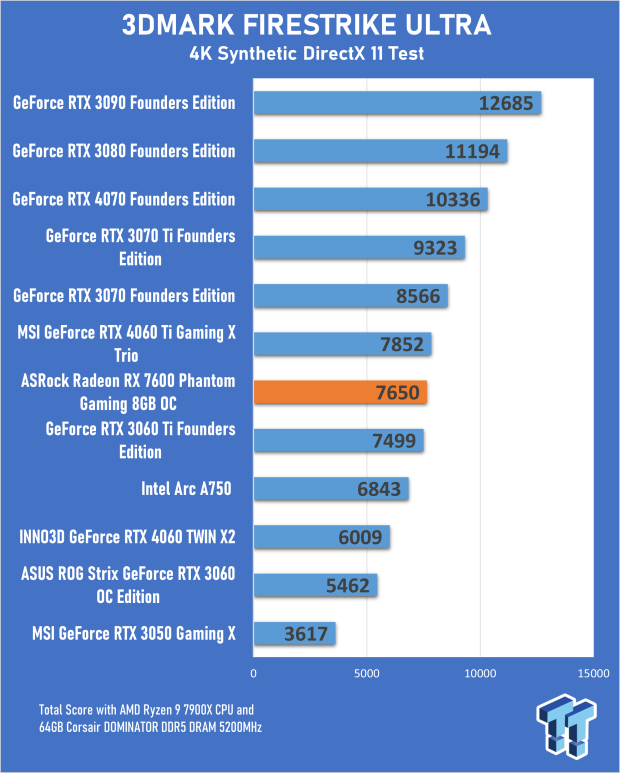
3DMark FireStrike is a DirectX 11 test that has been around for many years and covers quite a large portion of games released over the past decade - at least in terms of the API and graphics technologies used. The three tests cover the resolutions - 1080p, 1440p, and 4K. Normally, 3DMark benchmarks can indicate what to expect in-game, but that's not the case with the Radeon RX 7600. Here the 1080p baseline 3DMark FireStrike benchmark results paint a picture of the ASRock Radeon RX 7600 Phantom Gaming 8GB being 11.7% more powerful than the GeForce RTX 4060, with that lead increasing to 17.5% with the 1440p FireStrike Extreme test.
These results present a wildly different picture to the in-game benchmark results from our 15-game suite, making the mainstream RDNA 3 GPU look like a GeForce RTX 4060 Ti competitor. It does make you wonder if something has gone wrong on the driver side. In that, will the Radeon RX 7600 significantly improve over time and live up to the 'fine wine' adage associated with past Radeon products?
Benchmarks - 3DMark TimeSpy and Port Royal
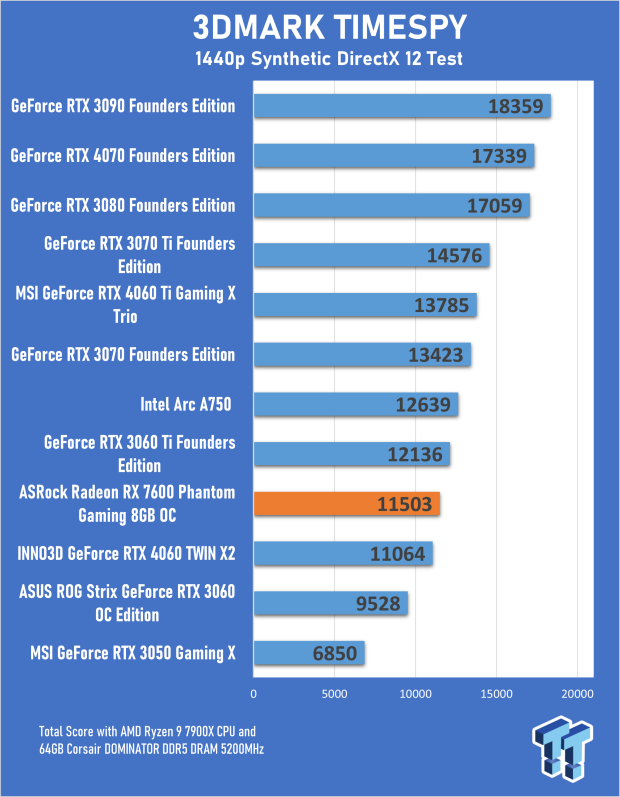
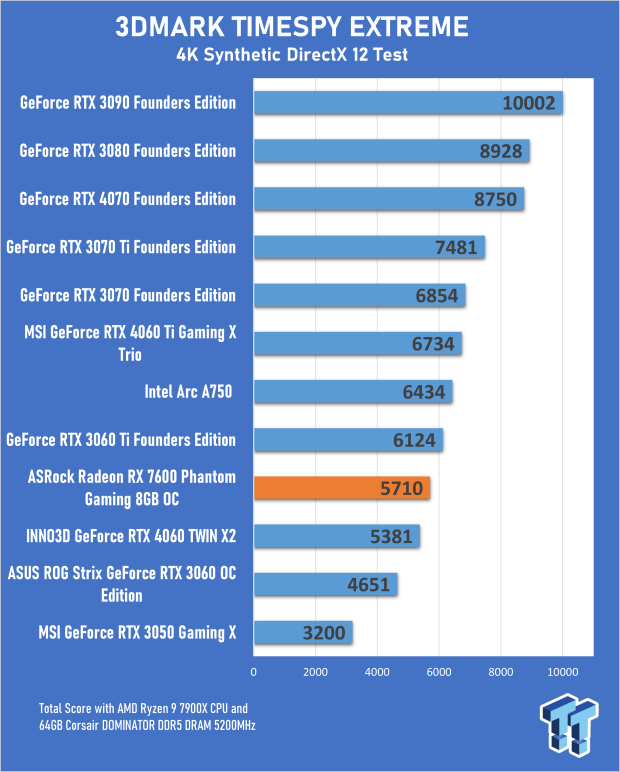
3DMark TimeSpy is DirectX 12-based, so it's a more relevant synthetic benchmark for modern games. Here, the results closely match the in-game benchmarks in that performance sits much closer to the GeForce RTX 4060, with a small 4% lead and a bigger 20.7% lead over the GeForce RTX 3060.
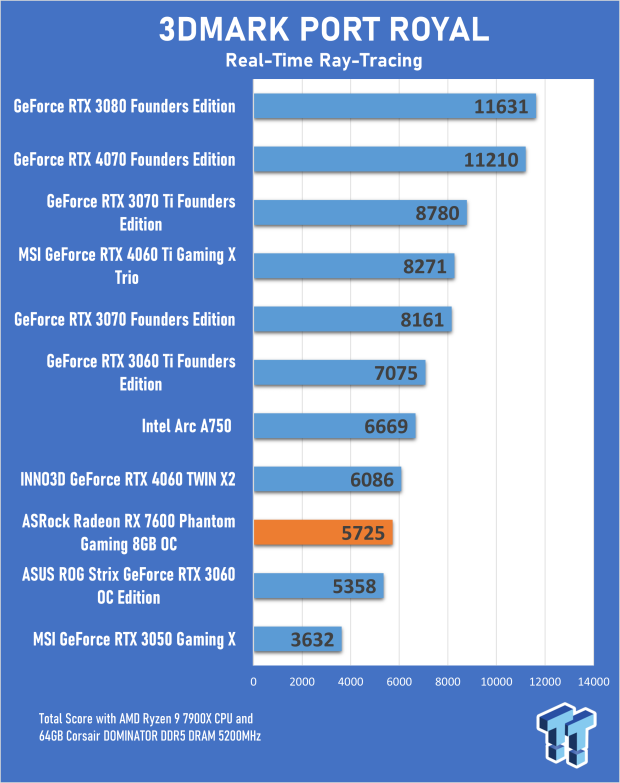
3DMark Port Royal is a synthetic ray-tracing benchmark -an area where AMD has traditionally fallen behind. Ray-tracing at the mainstream level still needs tech like DLSS and FSR 2 to deliver the best results, and with that, the ASRock Radeon RX 7600 Phantom Gaming 8GB sitting between the GeForce RTX 3060 and RTX 4060 is reflected (RT-style) in games like F1 22, where performance is on par with the GeForce RTX 4060. But, as mentioned earlier, in RT-heavy titles like Hitman and Cyberpunk 2077, the Radeon RX 7600 does fall apart - with performance dropping to near GeForce RTX 3050 and RTX 3060 levels.
Benchmarks - 1080p Gaming
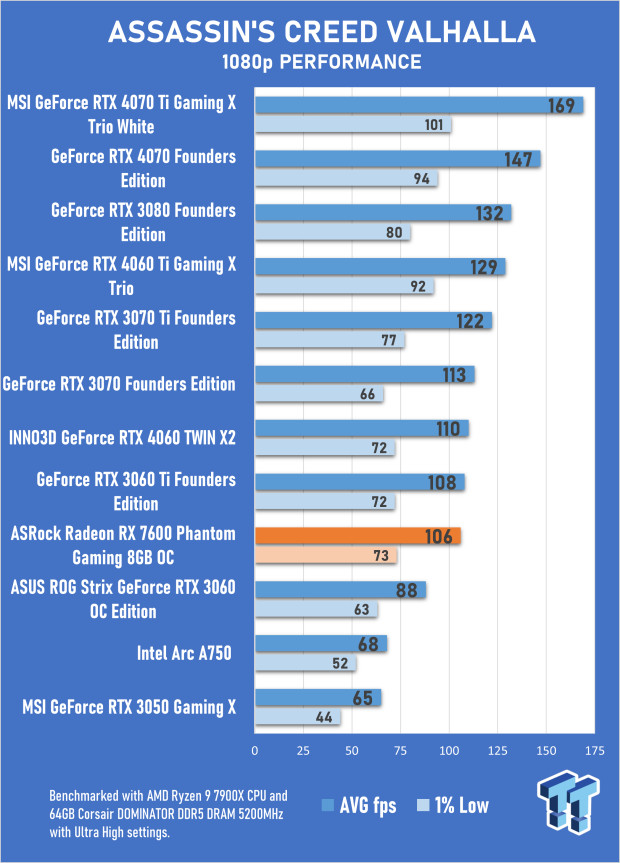
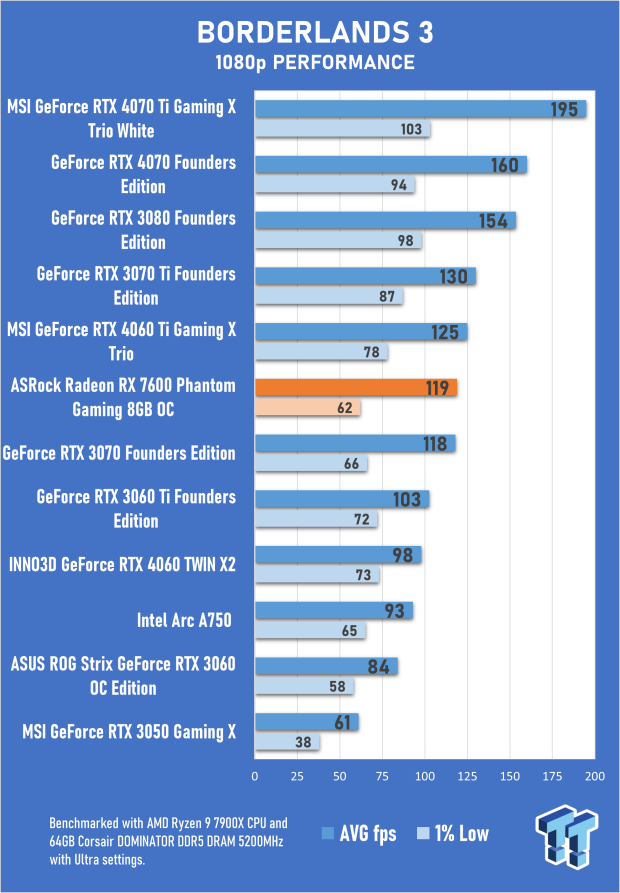
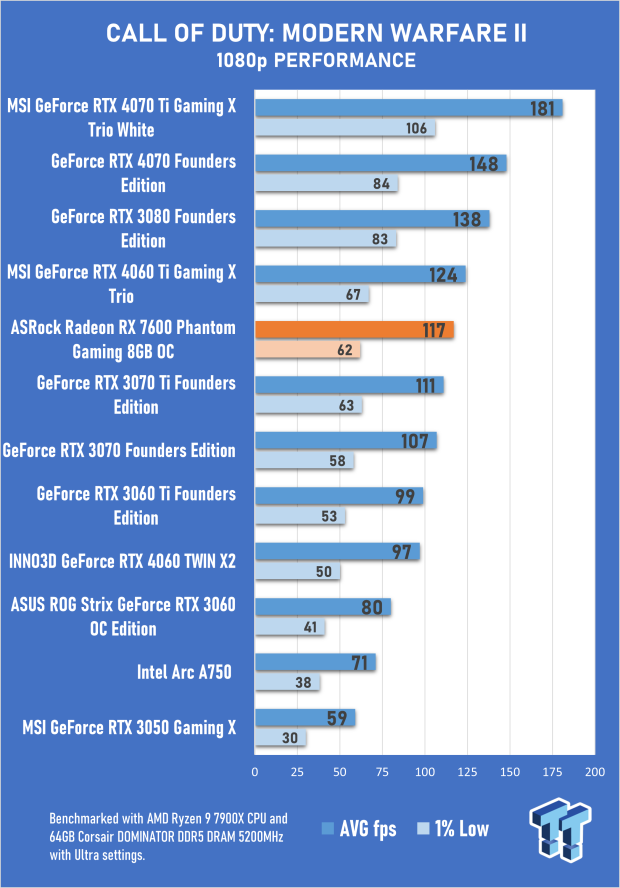
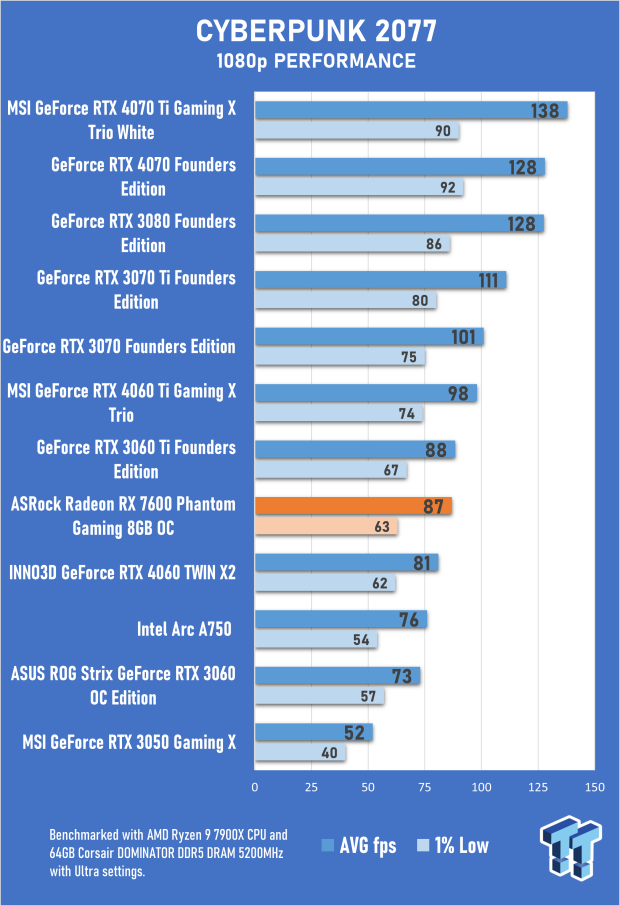
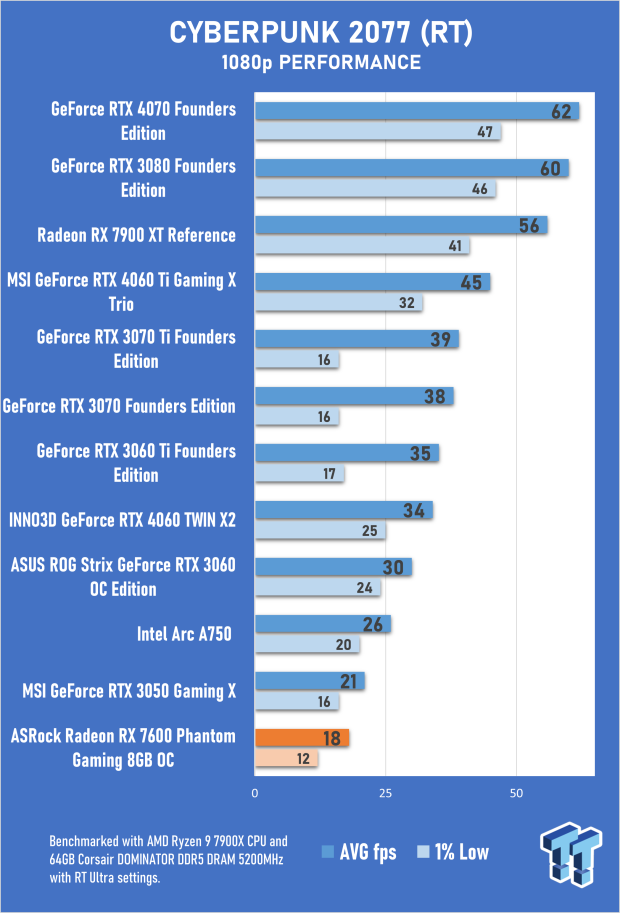
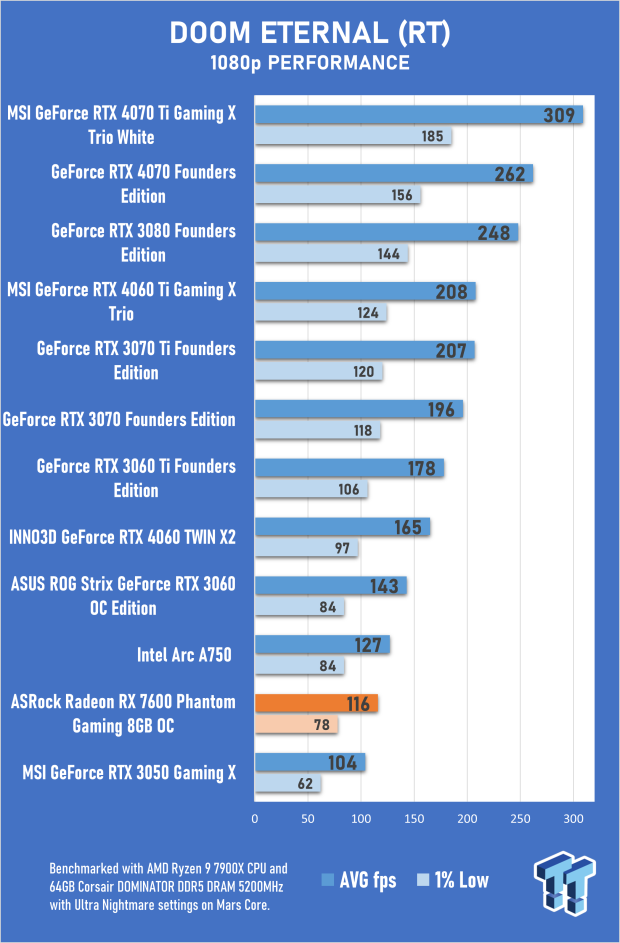
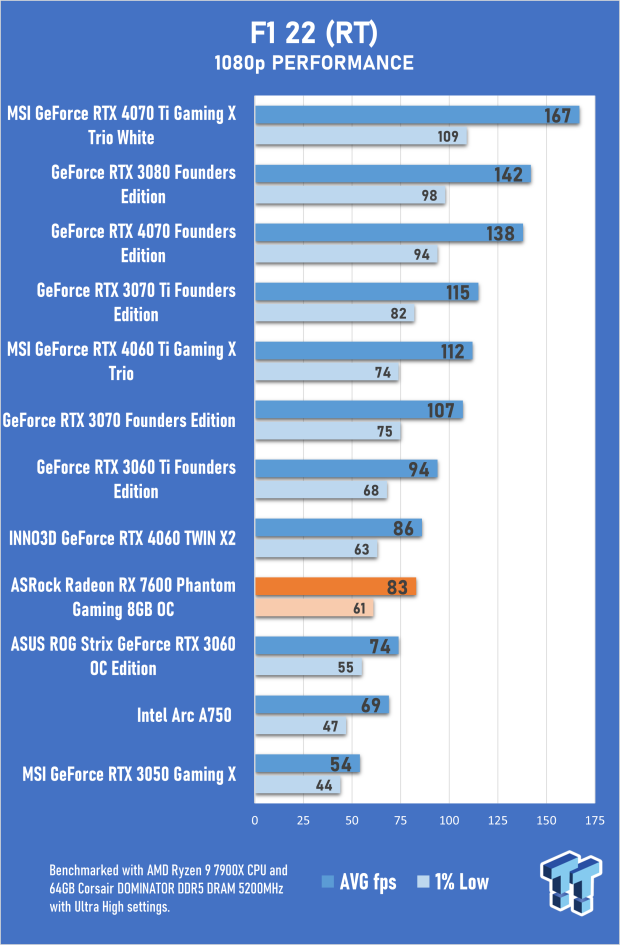
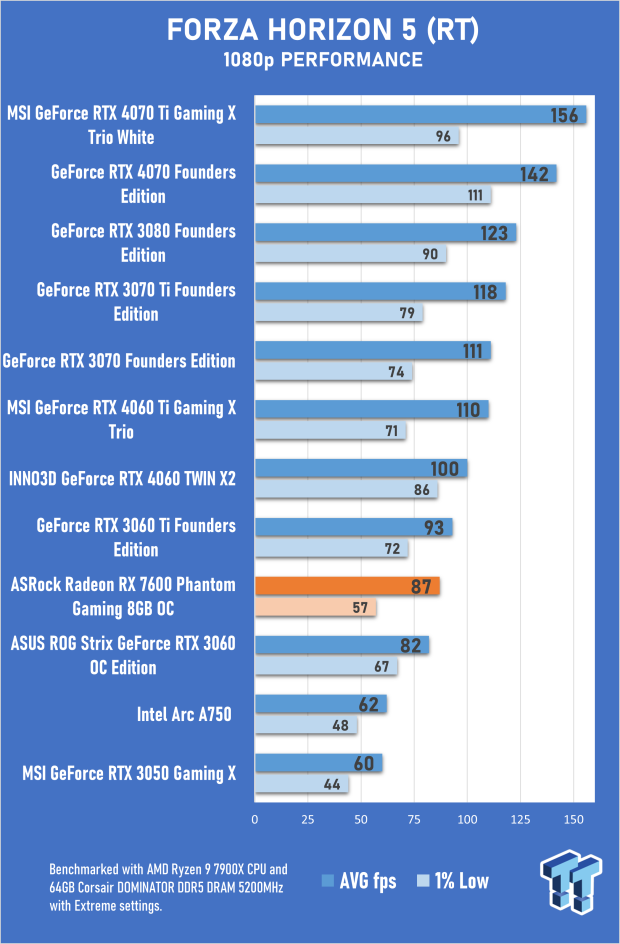
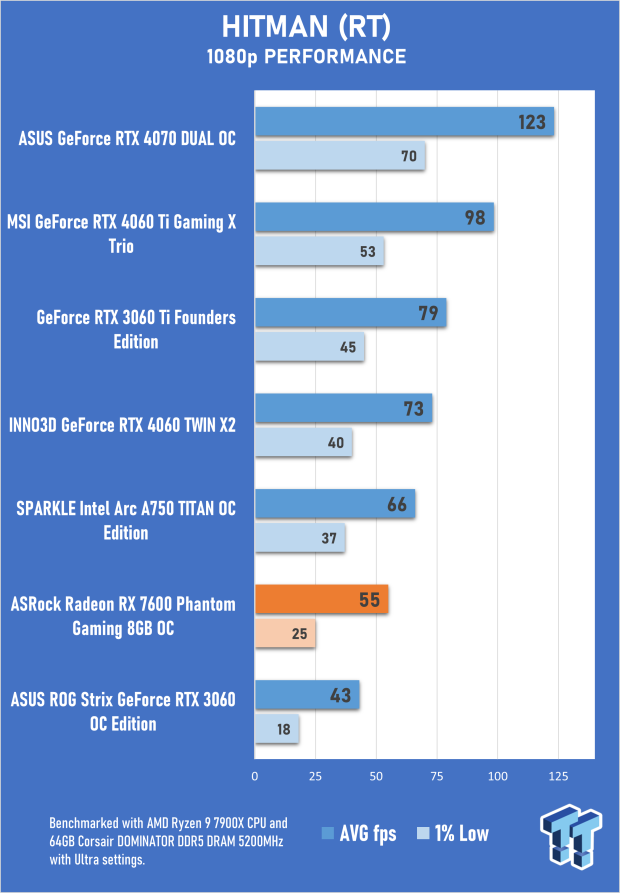
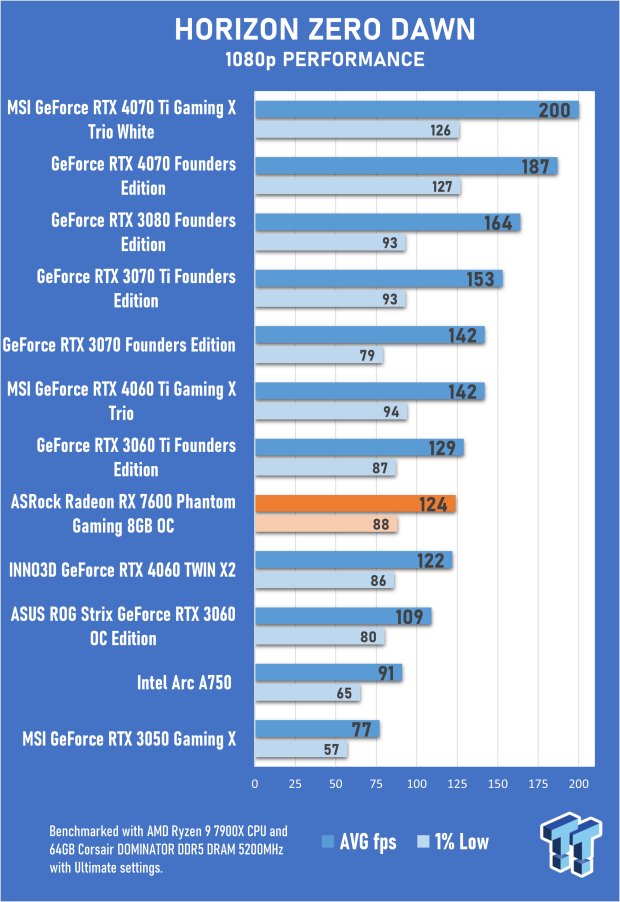
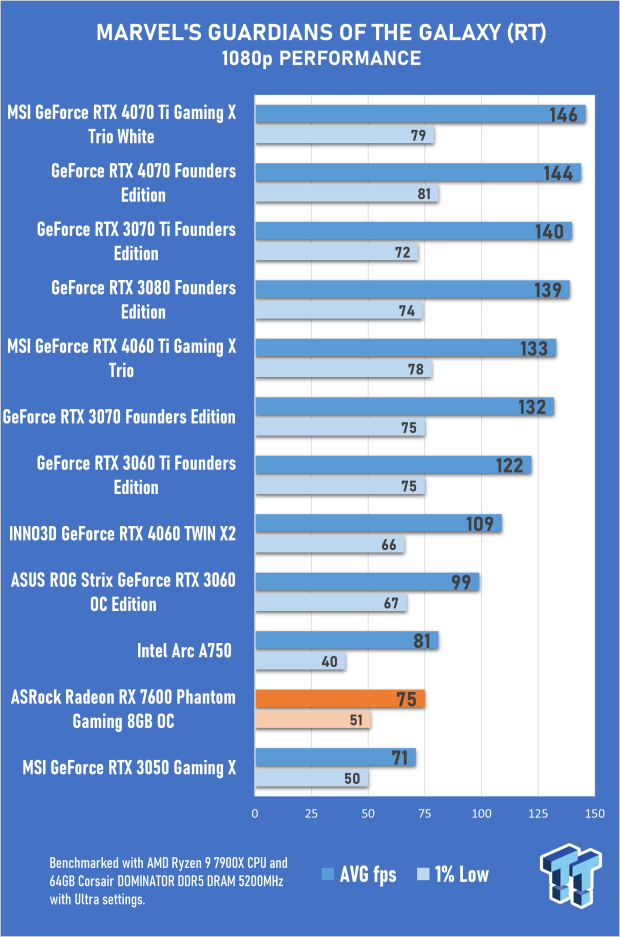
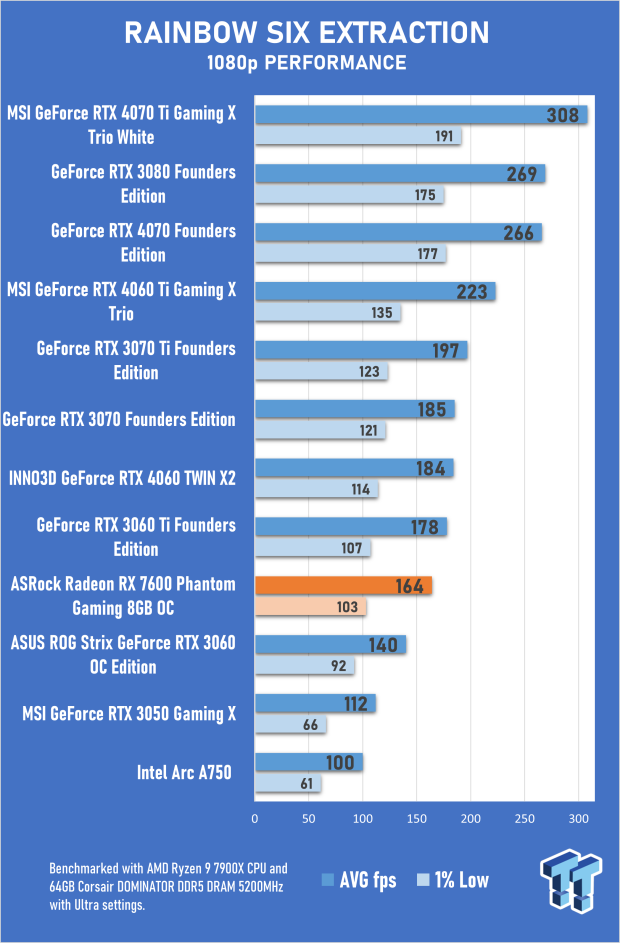
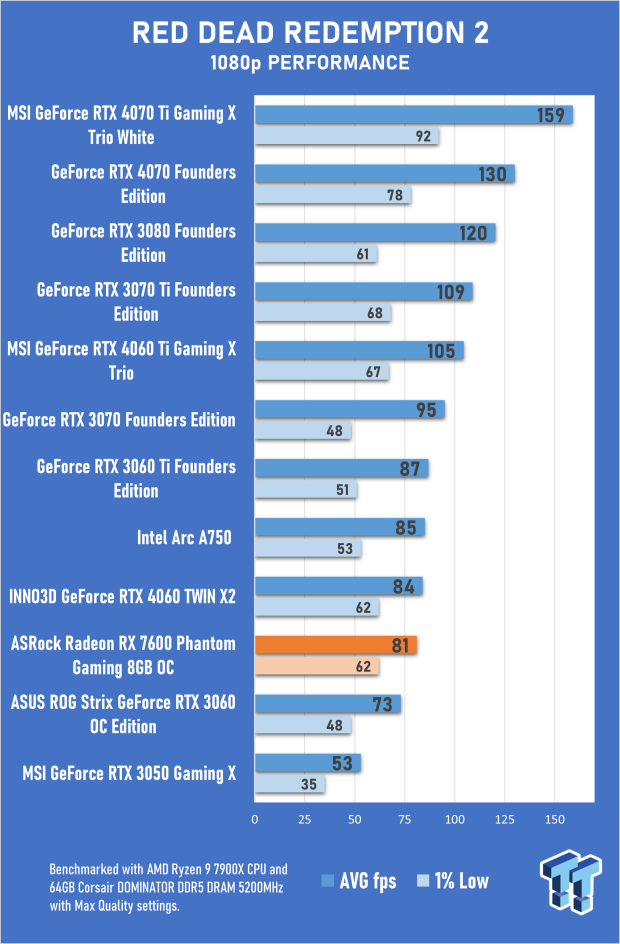
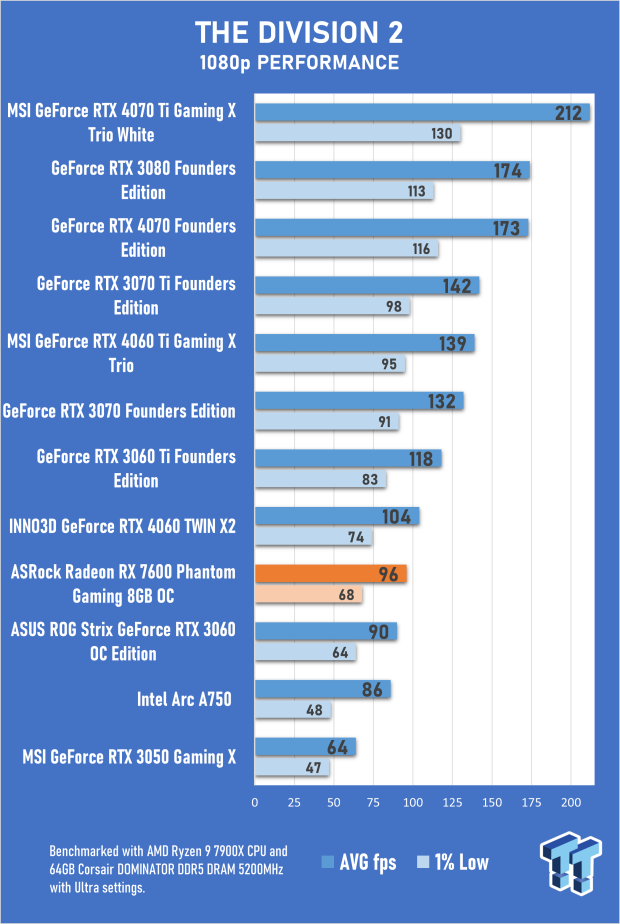
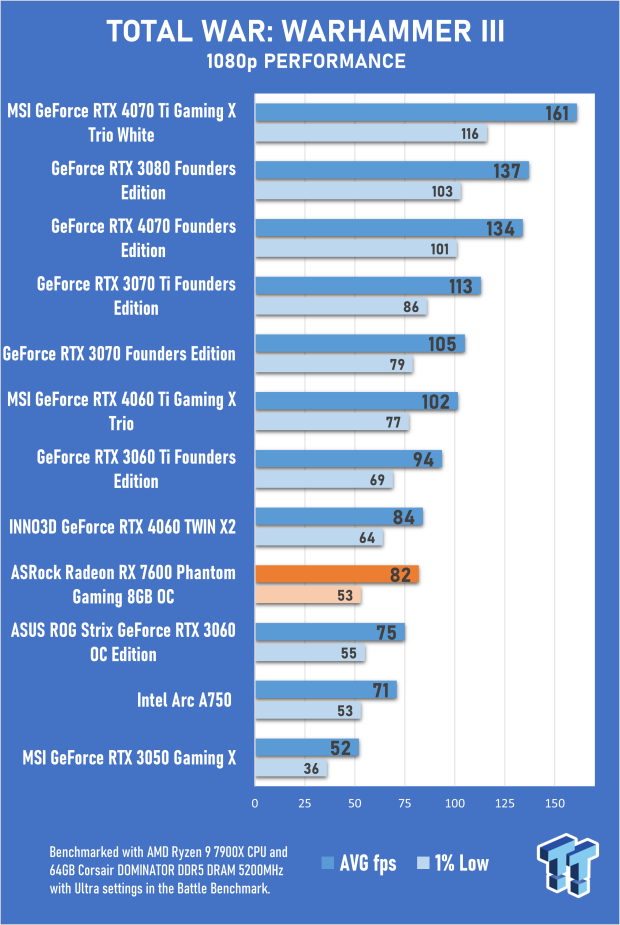
Benchmarks - 1440p Gaming
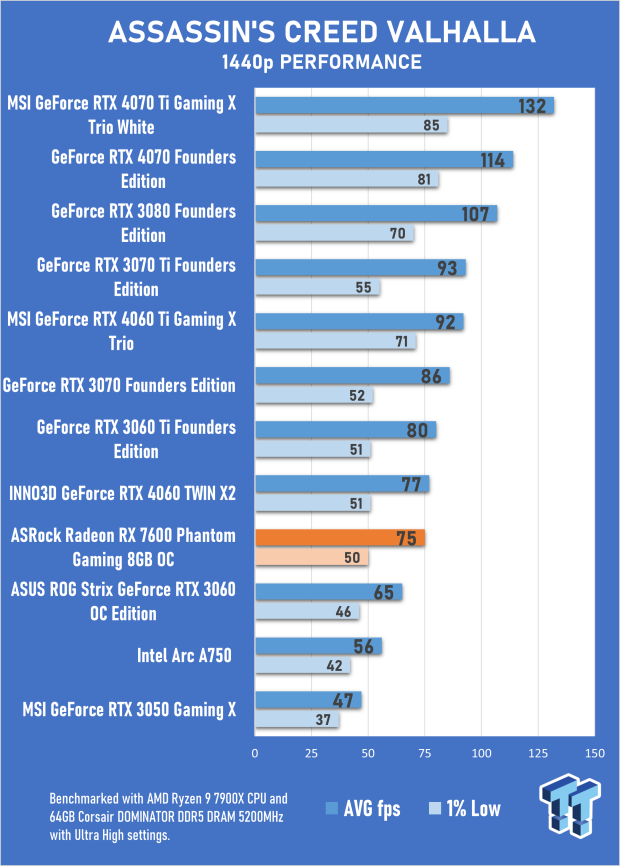
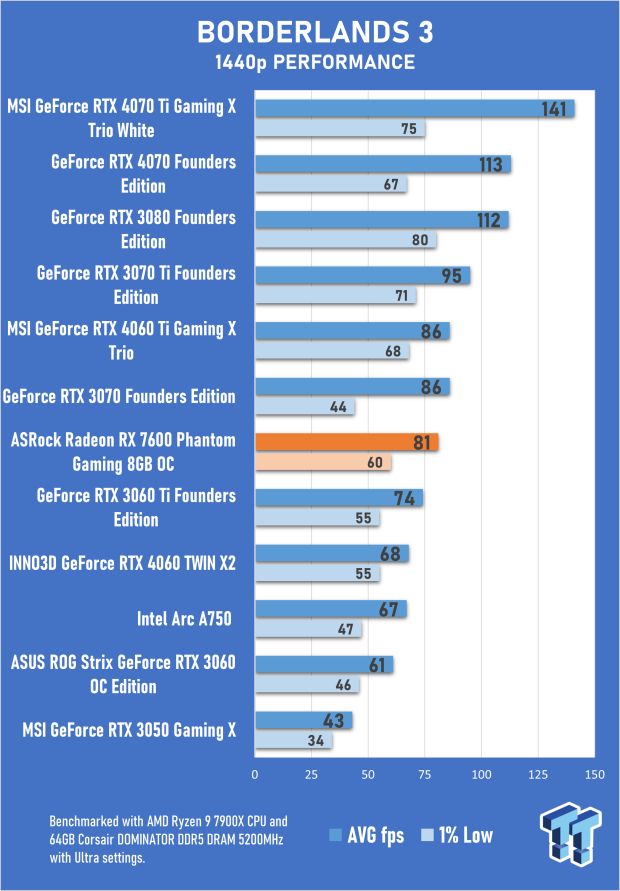
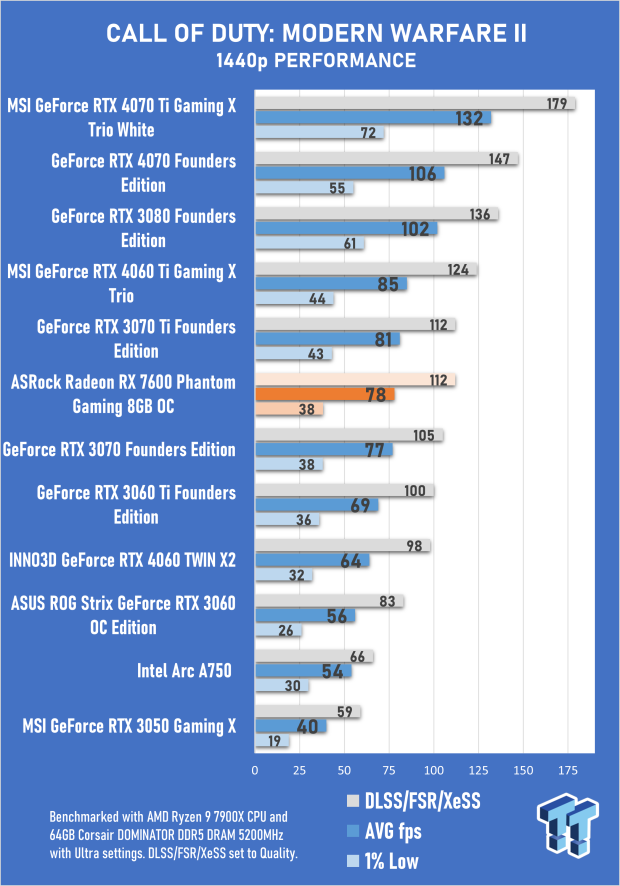
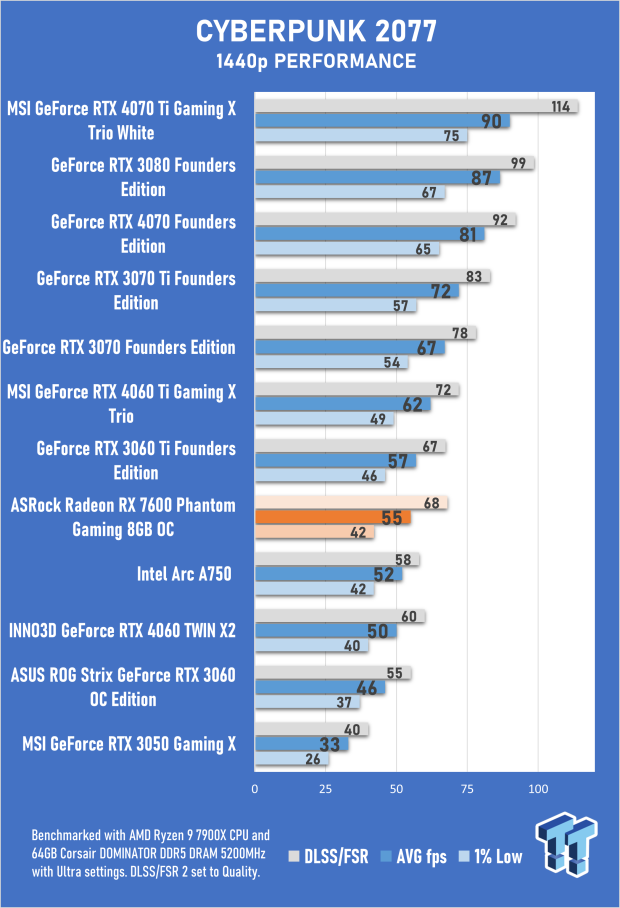
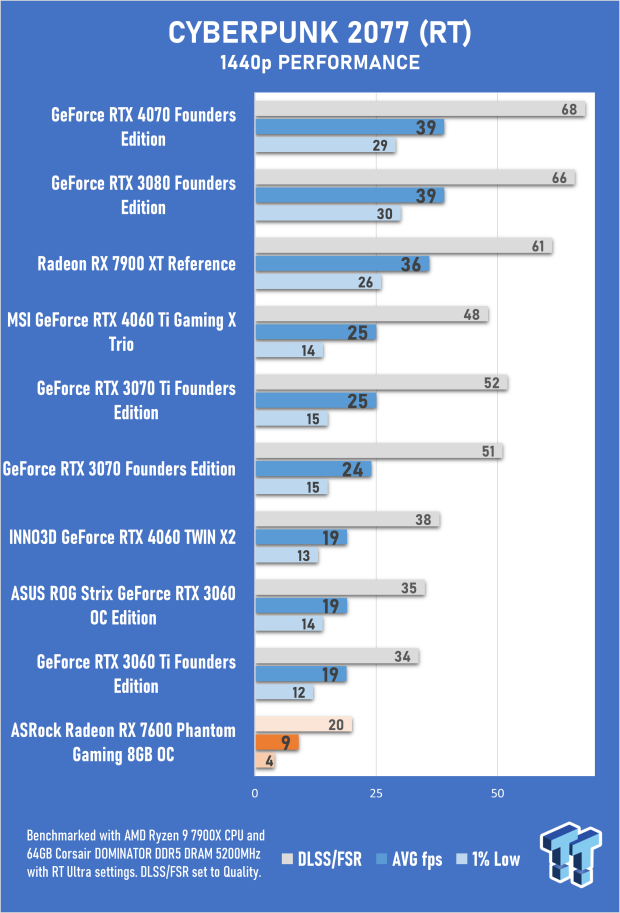
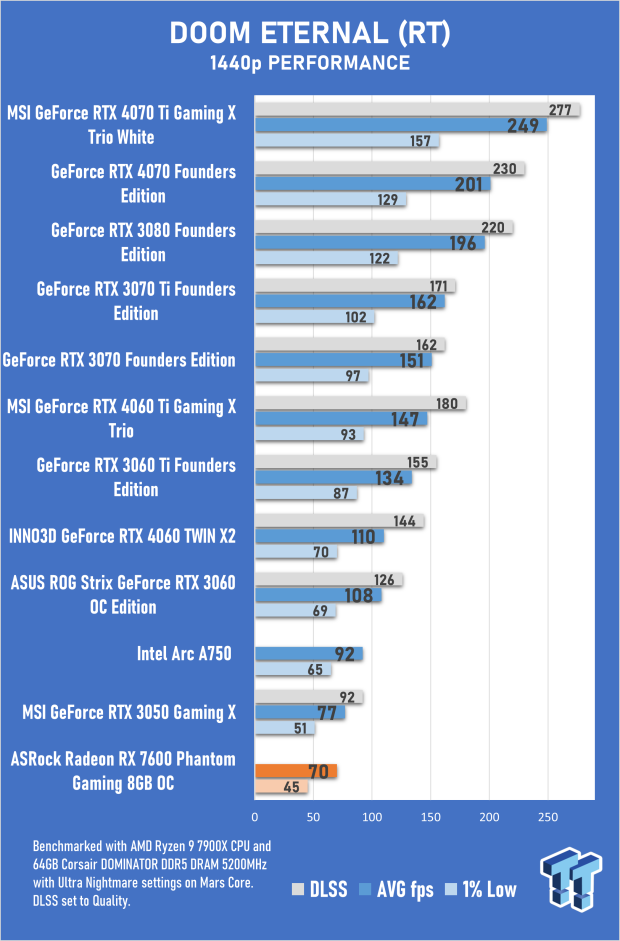
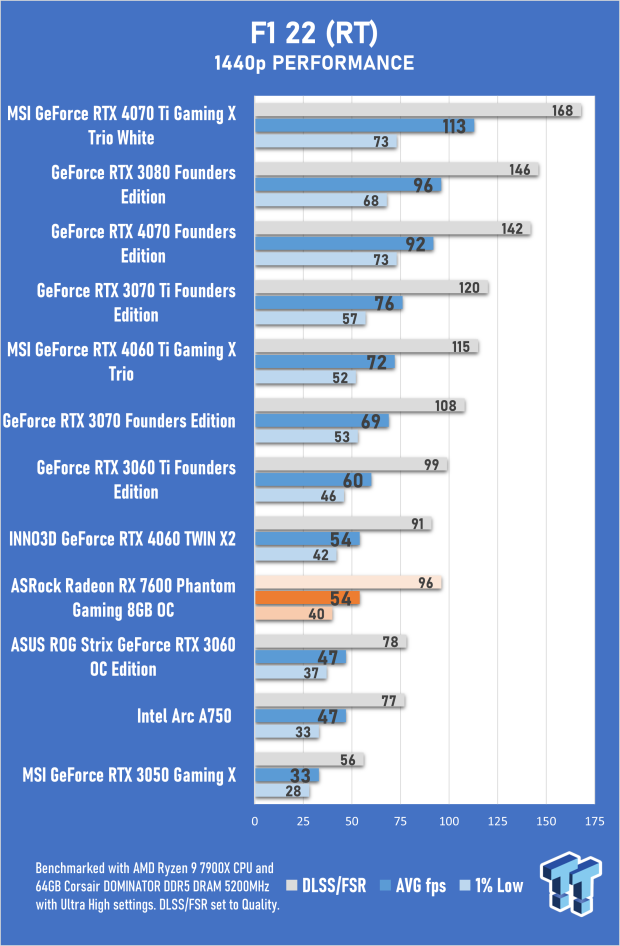
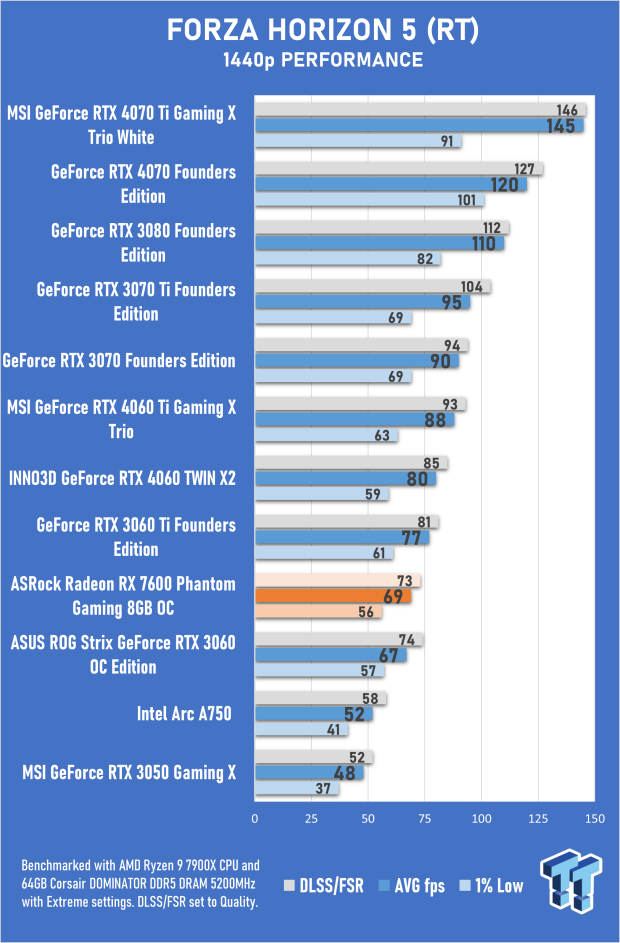
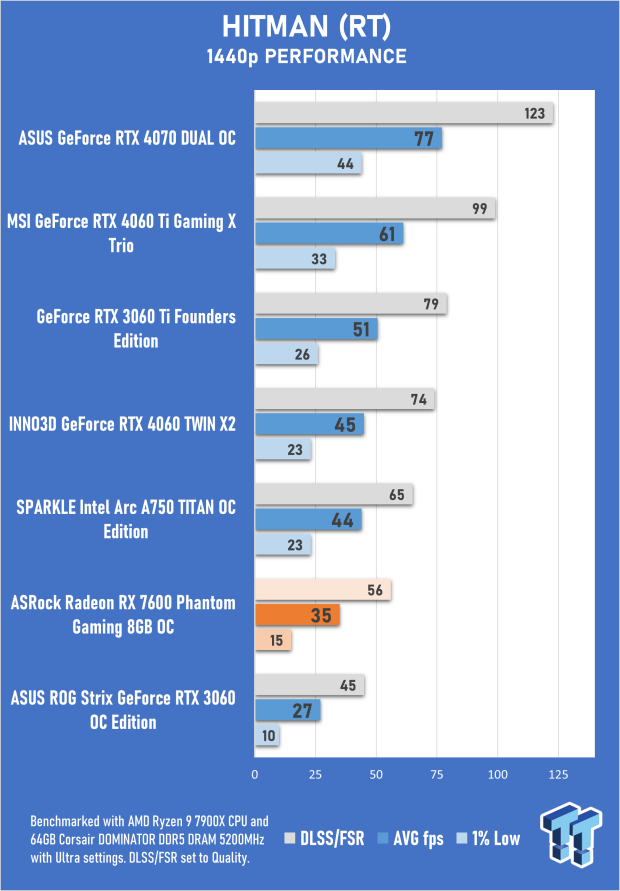
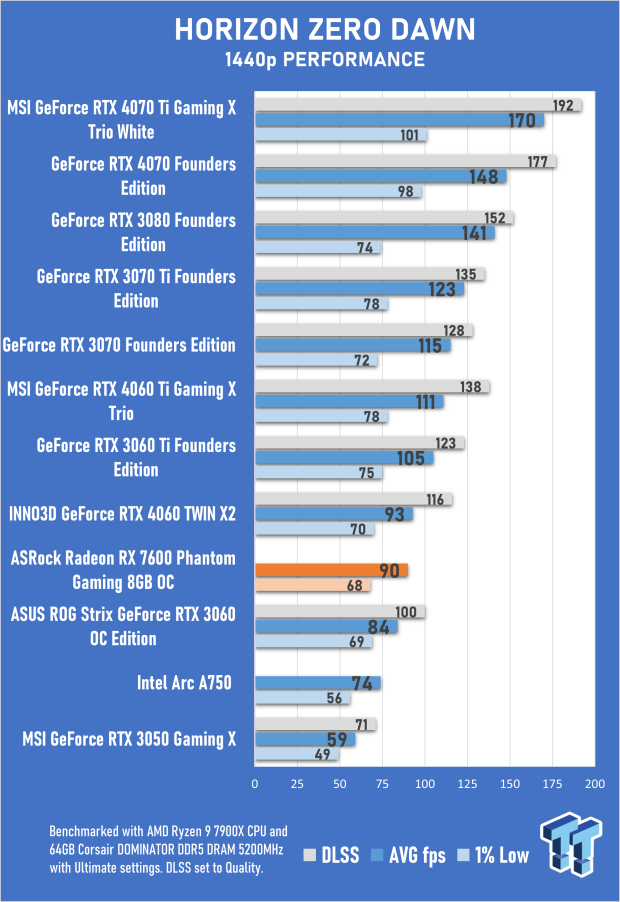
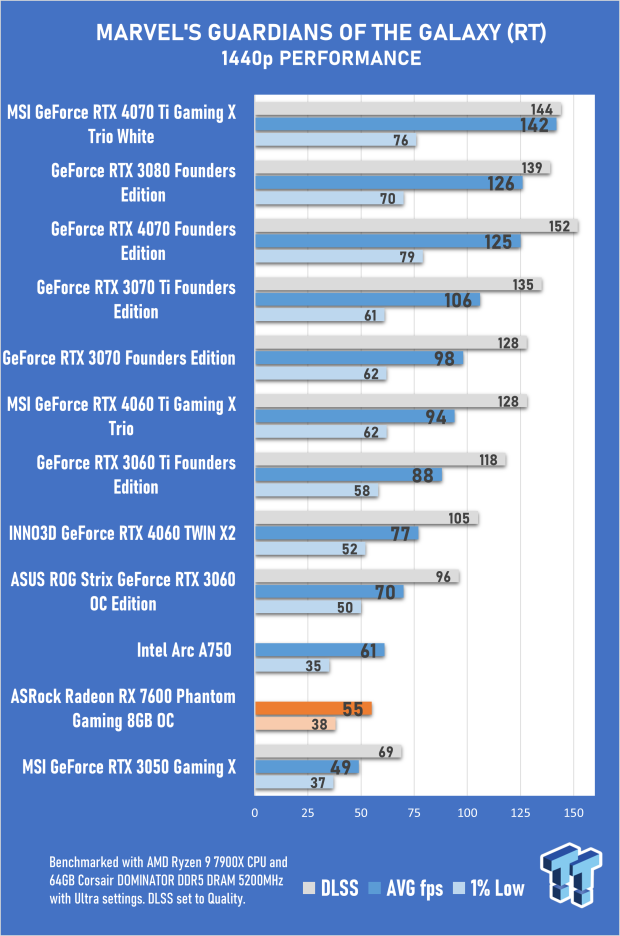
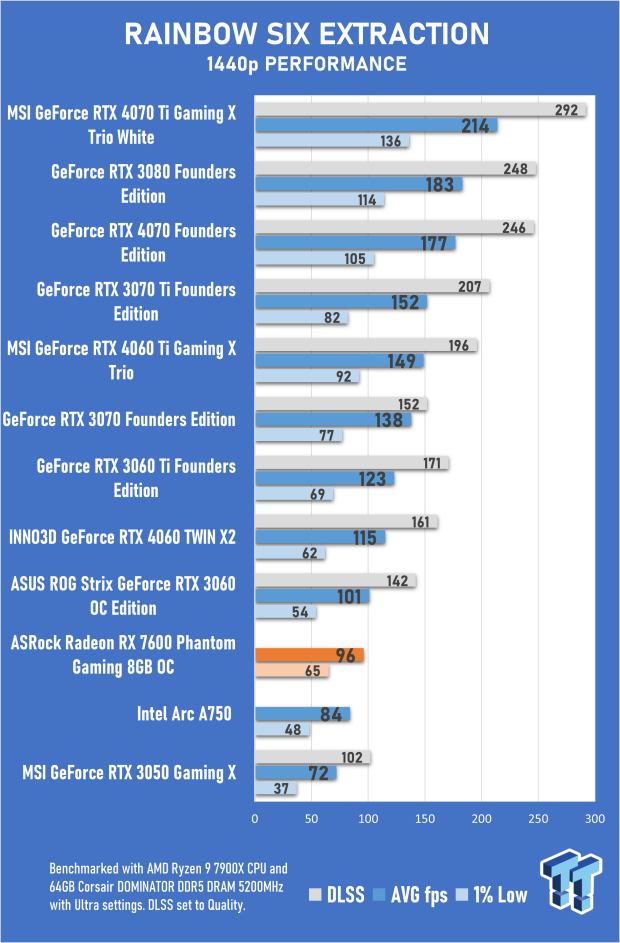
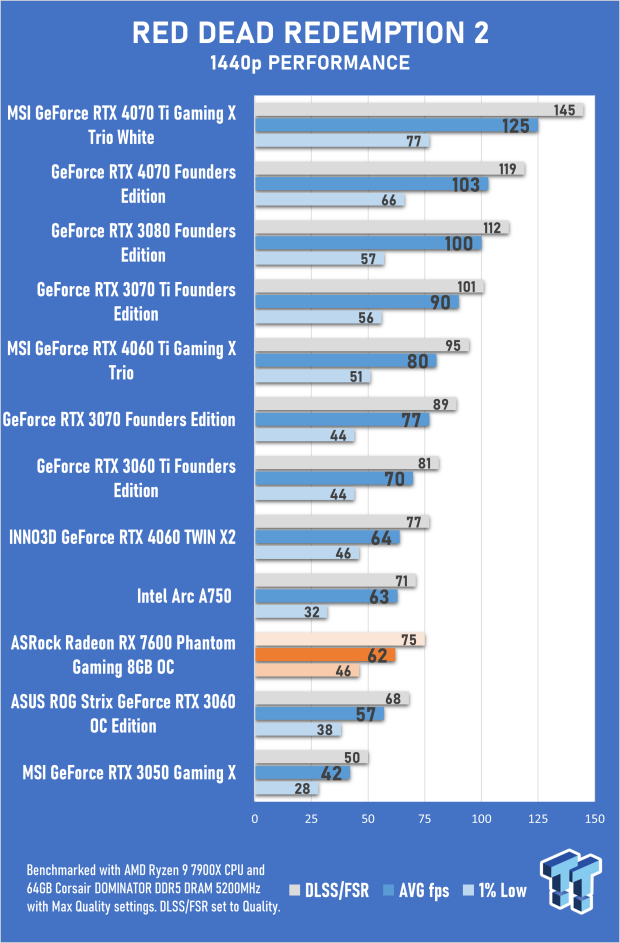
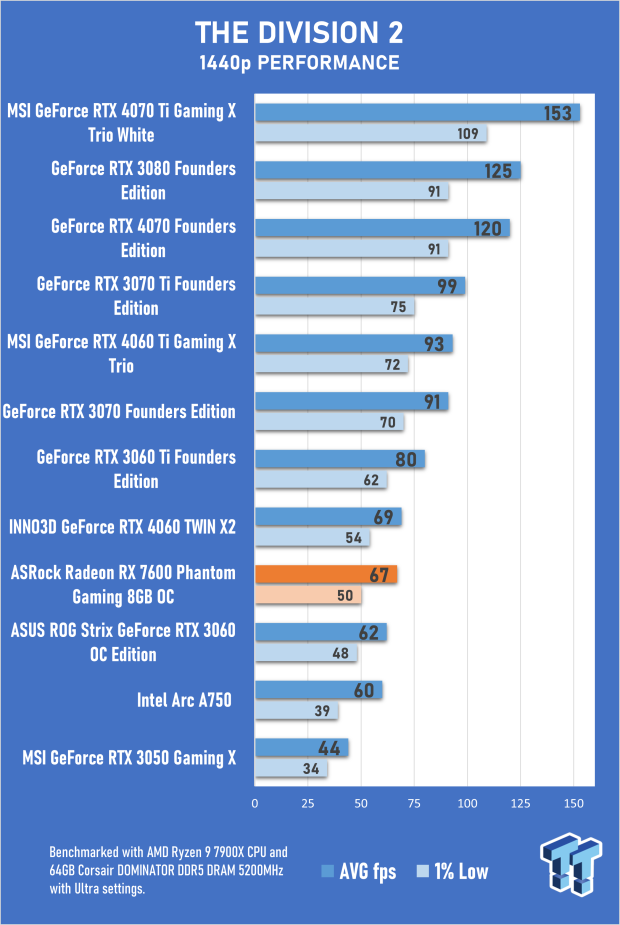
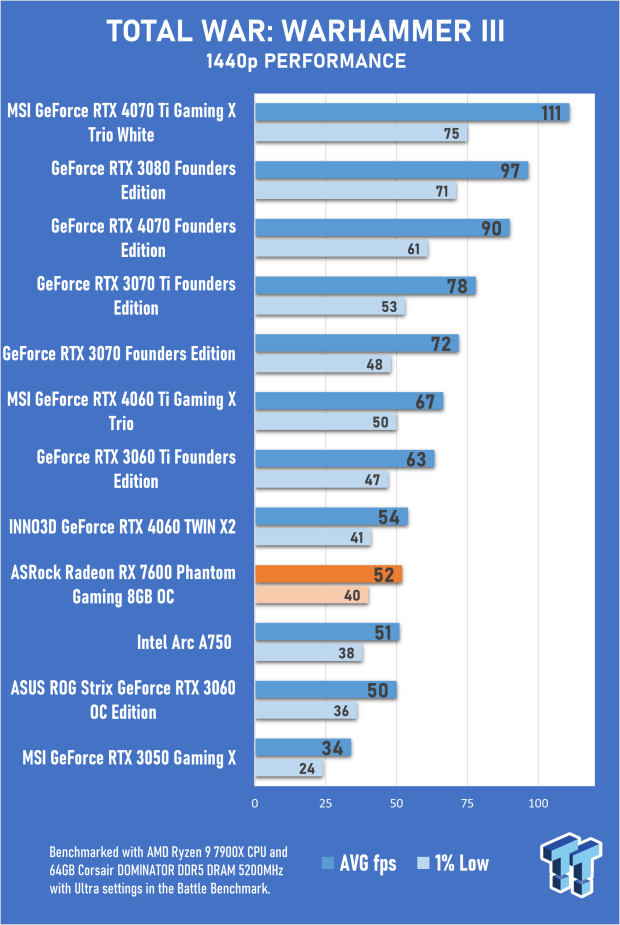
Benchmarks Summary, Ray-Tracing Performance, and FSR 2
With all of the individual benchmark results showcased above, it's clear that when it comes to 1080p and 1440p gaming, the ASRock Radeon RX 7600 Phantom Gaming 8GB can certainly deliver impressive results - albeit performance that generally sits in-between the GeForce RTX 3060 and RTX 4060. With 8GB of VRAM, it is better suited to 1080p gaming, though this will depend on the title - and as our in-game benchmarks are run with detail settings cranked. Tweaking a few things here and there does make it a decent 1440p offering.
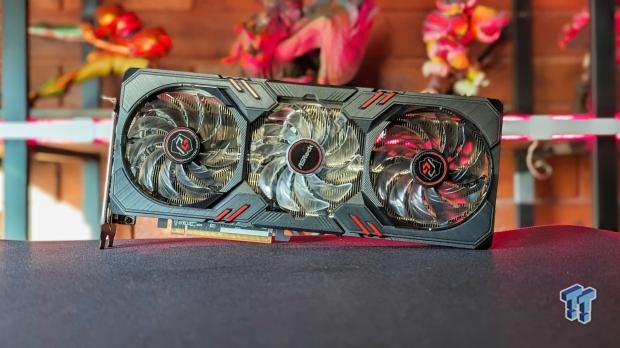
Even at the mainstream level, the Radeon RX 7600 benefits from the newer RDNA 3 architecture, from AV1 encoding to DisplayPort 2.1 support and improved RT hardware. AMD's FSR 2 is available in more titles than ever, and it helps deliver exceptional 1440p performance in titles like F1 22, Cyberpunk 2077, Call of Duty: Modern Warfare II, and others. It's a shame that we haven't seen (or heard about) AMD's DLSS 3 Frame Generation competitor in several months. DLSS3 and Frame Generation can deliver impressive results even on the mainstream GeForce RTX 4060, so here's hoping that FSR 3 is coming sooner rather than later.
Temperature and Power Efficiency
During our stress test, the ASRock Radeon RX 7600 Phantom Gaming 8GB drew roughly 180W of power, but with a GPU temperature of 55 degrees Celsius and a 20% fan speed of 1156 RPM, it's easily the best-cooled Radeon RX 7600 we've tested to date. The results showcase that ASRock might have gone a little overboard with the cooling, but it's a testament to what high-quality components and a great cooling design can bring to a GPU.
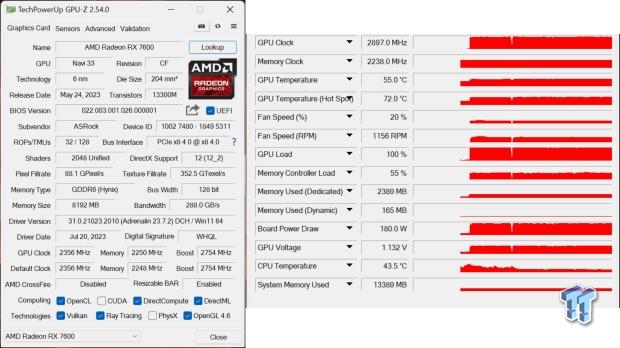
The cooling, sound levels, and thermal performance are all a class above AMD's Radeon RX 7600 design - and well worth paying that extra bit.
Final Thoughts
The mainstream GPU space is a little crowded at the moment, where the USD 200-300 price range covers the latest models from AMD, Intel, and NVIDIA, as well as previous generation cards that are now being sold at a discount. For GPUs like the Radeon RX 7600 and GeForce RTX 4060, this makes the question of value for money a little tricky. At its current price point, the ASRock Radeon RX 7600 Phantom Gaming 8GB is a solid 1080p performer, delivering a noticeable improvement over the previous gen model with the bonus of having the latest RDNA 3 architecture.
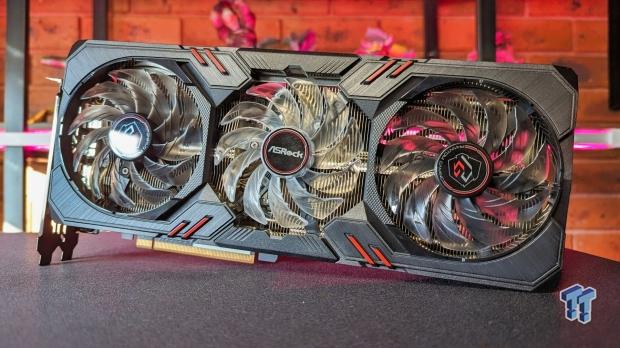
And even though it's a premium model commanding a few extra bucks over the MSRP, the ASRock Radeon RX 7600 Phantom Gaming 8GB is one of the best mainstream RDNA 3 cards currently available - from performance to cooling to the build quality and overall aesthetics. ASRock continues to impress, even when the underlying architecture sometimes fails to reach its potential.

